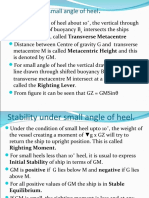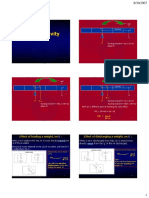0 ratings0% found this document useful (0 votes)
61 viewsCss Code
css
Uploaded by
Rohit PandeyCopyright
© © All Rights Reserved
Available Formats
Download as PDF or read online on Scribd
0 ratings0% found this document useful (0 votes)
61 viewsCss Code
css
Uploaded by
Rohit PandeyCopyright
© © All Rights Reserved
Available Formats
Download as PDF or read online on Scribd
You are on page 1/ 5
Mates Orals Notes Function 2 - Cargo
CODE OF SAFE PRACTICE FOR CARGO STOWAGE AND SECURING
(CSS Code) (2011 Edition)
Also called Lashing Code by MMD Surveyors
This publication presents amendments to the CSS Code, as amended. The most recent
amendments,
approved at the eighty-seventh session of the Maritime Safety Committee (12 to 21 May 2010),
include a new annex 14 on Guidance on providing safe working conditions for securing of
containers on deck.
Also included are:
+ Revised guidelines for the preparation of the Cargo Securing Manual approved in May 2010;
+ Elements to be taken into account when considering the safe stowage and securing of cargo
units and vehicles in ships, as amended in 2010;
+ Amendments to the guidelines for securing arrangements for the transport of road vehicles
on ro-ro ships, as amended in 2010,
The proper stowage and securing of cargoes is of the utmost importance for the safety of life at
sea. Improper stowage and securing of cargoes has resulted in numerous serious ship casualties
and caused injury and loss of life, not only at sea but also during loading and discharge. In order to
deal with the problems and hazards arising from improper stowage and securing of certain cargoes
on ships, the International Maritime Organization (IMO) has issued guidelines in the form of either
Assembly resolutions or circulars adopted by the Maritime Safety Committee (MSC);
these are listed hereunder:
* Safe stowage and securing of cargo units and other entities in ships other than cellular
containerships, resolution A.489(Xll) [ appendix 1];
Guidelines for the preparation of the Cargo Securing Manual, MSC/Circ. 745 [ appendix 2];
Elements to be taken into account when considering the safe stowage and securing of cargo
units and vehicles in ships, resolution A.533 (13) [ appendix 3];
* Guidelines for securing arrangements for the transport of road vehicles on ro-ro ships,
resolution A.581 (14), as amended [ appendix 4];
‘+ IMO/ILO/UN ECE Guidelines for packing of cargo transport units [see the Supplement to the
IMDG Code (sales number IH210E)];
+ Recommendations for entering enclosed spaces aboard ships, resolution A.864 (20)
[ appendix 5].
The accelerations acting on a ship in a seaway result from a combination of longitudinal, vertical
and predominantly transverse motions. The forces created by these accelerations give rise to the
majority of securing problems. The hazards arising from these forces should be dealt with by taking
measures both to ensure proper stowage and securing of cargoes on board and to reduce the
amplitude and frequency of ship motions,
Compiled by Gursimranjit Randhawa #
Mates Orals Notes Function 2 - Cargo
The purpose of this Code is to provide an international standard to promote the safe
stowage and securing of cargoes by:
‘* drawing the attention of shipowners and ship operators to the need to ensure that the ship is.
suitable for its intended purpose;
providing advice to ensure that the ship is equipped with proper cargo securing means;
providing general advice conceming the proper stowage and securing of cargoes to
minimize the risks to the ship and personnel;
* providing specific advice on those cargoes which are known to create difficulties and
hazards with regard to their stowage and securing;
advising on actions which may be taken in heavy sea conditions; and
advising on actions which may be taken to remedy the effects of cargo shifting
Code of Safe Practice for Cargo Stowage and Securing
in providing such advice, it should be borne in mind that the master is responsible for the
safe conduct of the voyage and the safety of the ship, its crew and its cargo.
General principles
All cargoes should be stowed and secured in such a way that the ship and persons on board
are not put at risk. The safe stowage and securing of cargoes depend on proper planning,
execution and supervision. Personnel commissioned to tasks of cargo stowage and securing
should be properly
qualified and experienced. Personnel planning and supervising the stowage and securing of cargo
should have a sound practical knowledge of the application and content of the Cargo Securing
Manual, if provided.
In all cases, improper stowage and securing of cargo will be potentially hazardous to the securing
of other cargoes and to the ship itself. Decisions taken for measures of stowage and securing
cargo should be based on the most severe weather conditions which may be expected by
experience for the intended voyage.
Ship-handling decisions taken by the master, especially in bad weather conditions, should take into
account the type and stowage position of the cargo and the securing arrangements.
Compiled by Gursimranjit Randhawa #
Mates Orals Notes Function 2 - Cargo
Chapter 1
Chapter 2
Chapter 3
Chapter 4
Chapter 5
Chapter 6
Chapter 7
Annex 1
Annex 2
Annex 3
Annex 4
Annex 5
Annex 6
Annex 7
Annex &
Annex 9
Annex 10
Annex 11
Annex 12
Annex 13
Annex 14
Contents of CSS Cod
General
Principles of safe stowage and securing of cargoes
Standardized stowage and securing systems
Semi-standardized stowage and securing
Non-standardized stowage and securing
Actions which may be taken in heavy weather
Actions which may be taken once cargo has shifted.
Safe stowage and securing of containers on deck of ships which are not
specially designed and fitted for the purpose of carrying containers
Safe stowage and securing of portable tanks
Safe stowage and securing of portable receptacles-
Whe inthis annex the term receptacles used, lis meant to include both receptacles and cylinders.
Safe stowage and securing of wheel-based (rolling) cargoes
Safe stowage and securing of heavy cargo items such as locomotives,
transformers, etc.
Safe stowage and securing of coiled sheet steel
Safe stowage and securing of heavy metal products
Safe stowage and securing of anchor chains
Safe stowage and securing of metal scrap in bulk
Safe stowage and securing of flexible intermediate bulk containers
General guidelines for the under-deck stowage of logs
Safe stowage and securing of unit loads
Methods to assess the efficiency of securing arrangements for non-
standardized cargo
Guidance on providing safe working conditions for securing of containers on
deck
Compiled by Gursimranjit Randhawa # Page 73
Mates Orals Notes Function 2 - Cargo
INTERNATIONAL CONVENTION FOR SAFE CONTAINERS,1972
(€SC 1972) (2014 Eaition)
The International Convention for Safe Containers, 1972 (CSC 1972) has two goals:
+ to maintain a high level of safety of human life in the transport and handling of containers by
providing acceptable test procedures and related strength requirements; and
+ to provide uniform international safety regulations, equally applicable to all modes of surface
transport, thereby avoiding the proliferation of divergent national regulations.
The amendments to CSC 1972 adopted by resolution MSC,355(92) entered into force on 1 July
2014 and include:
+ new definitions at the beginning of annexes | and Il, along with consequential amendments
to ensure uniform usage of terminology throughout CSC 1972;
+ amendments to align all physical dimensions and units to the SI system;
+ the introduction of a transitional period for marking containers with restricted stacking
capacity, as required under the relevant standard; and
+ the inclusion in annex IIl of the list of deficiencies which do not require an immediate out-of-
service decision by the control officer but do require additional safety measures to enable
safe ongoing transport.
Compiled by Gursimranjit Randhawa #
Mates Orals Notes Function 2 - Cargo
Contents of CSC Code
1 INTRODUCTION
2 INTERPRETATIONS
21 General
2.2 Definitions
23 Application
24 Entry into force
25 Testing, inspection and approval
26 Approval of containers for foreign owners or manufacturers
27 Maintenance and structural modifications
28 Withdrawal of approval
29 Control
2.10 Safety Approval Plate
2.11 Maintenance and examination procedures
2.12 Records of examinations
2.13 Frequency of examinations
2.14 Modifications of existing containers
2.15 Test methods and requirements
2.16 Stacking test
2.17 Longitudinal Restraint (Static Test)
3 GUIDELINES
34 Objectives
32 Scope
33 Approval and testing of containers
3.4 Approval of Offshore Containers handled in open seas
3.5 Serious Structural Deficiencies in containers
3.6 Safety Approval Plates
37 Maintenance and examination procedures
3.8 Maintenance and Examination Scheme Approval and Control
3.9 Sale Containers
3.10 One-way trip containers
3.11 Ratification
3.12 Control
3.13 Disputes
Annex 1 SERIOUS STRUCTURAL DEFICIENCIES IN CONTAINERS
Annex 2 Resolution A.737 (18) adopted on November 4th 1993
Annex 3 MAIN TYPES OF CONTAINERS
Annex 4 ISO STANDARDS RELATING TO CONTAINERS
Annex 5 SIGNATORY STATES TO THE CONVENTION
Annex6 SAFETY APPROVAL PLATE
Annex7 ANNUAL DECAL COLOURS
Compiled by Gursimranjit Randhawa #
You might also like
- Ejemplos Resueltos Variación Del Centro de Gravedad de Un Buque Debido Al MovimientoNo ratings yetEjemplos Resueltos Variación Del Centro de Gravedad de Un Buque Debido Al Movimiento8 pages
- Adverse Stability: Check You Progress NameNo ratings yetAdverse Stability: Check You Progress Name3 pages
- SHIP B - Data-Booklet-MCA-SQA-Chief-Mate-Stability-Book-B-V1.2-January-2022No ratings yetSHIP B - Data-Booklet-MCA-SQA-Chief-Mate-Stability-Book-B-V1.2-January-202269 pages
- HR0L 35 LO 3 S2 (Shear Forces and Bending Moments) - 464458981No ratings yetHR0L 35 LO 3 S2 (Shear Forces and Bending Moments) - 46445898121 pages
- DNS Stability Key DG Module 9 MVH Q 20,21 03,04 June 2020No ratings yetDNS Stability Key DG Module 9 MVH Q 20,21 03,04 June 20204 pages
- 111effect of Cargo Including Heavy Lifts On The100% (1)111effect of Cargo Including Heavy Lifts On The37 pages
- International Convention On Tonnage Measurement of SHIPS, 1969 Precautions To Minimize Adverse Economic Impact of The Tonnage Convention100% (1)International Convention On Tonnage Measurement of SHIPS, 1969 Precautions To Minimize Adverse Economic Impact of The Tonnage Convention40 pages
- 4 1.1 PPT Importance of Maintaining Stability During Loading100% (1)4 1.1 PPT Importance of Maintaining Stability During Loading32 pages
- 1539055397phase 2 Subra CH 8 Solved by KS ChadhaNo ratings yet1539055397phase 2 Subra CH 8 Solved by KS Chadha17 pages
- Section 23 Intact and Damage Stability: I - Part 6 GL 2010 Page 23-1No ratings yetSection 23 Intact and Damage Stability: I - Part 6 GL 2010 Page 23-18 pages
- Bb-09.Addendum of Trim, Stability BookletNo ratings yetBb-09.Addendum of Trim, Stability Booklet32 pages
- Imo 2003 Edition Cargo Stowage and SecuringNo ratings yetImo 2003 Edition Cargo Stowage and Securing111 pages
- Ejemplos Resueltos Variación Del Centro de Gravedad de Un Buque Debido Al MovimientoEjemplos Resueltos Variación Del Centro de Gravedad de Un Buque Debido Al Movimiento
- SHIP B - Data-Booklet-MCA-SQA-Chief-Mate-Stability-Book-B-V1.2-January-2022SHIP B - Data-Booklet-MCA-SQA-Chief-Mate-Stability-Book-B-V1.2-January-2022
- HR0L 35 LO 3 S2 (Shear Forces and Bending Moments) - 464458981HR0L 35 LO 3 S2 (Shear Forces and Bending Moments) - 464458981
- DNS Stability Key DG Module 9 MVH Q 20,21 03,04 June 2020DNS Stability Key DG Module 9 MVH Q 20,21 03,04 June 2020
- International Convention On Tonnage Measurement of SHIPS, 1969 Precautions To Minimize Adverse Economic Impact of The Tonnage ConventionInternational Convention On Tonnage Measurement of SHIPS, 1969 Precautions To Minimize Adverse Economic Impact of The Tonnage Convention
- 4 1.1 PPT Importance of Maintaining Stability During Loading4 1.1 PPT Importance of Maintaining Stability During Loading
- Section 23 Intact and Damage Stability: I - Part 6 GL 2010 Page 23-1Section 23 Intact and Damage Stability: I - Part 6 GL 2010 Page 23-1



























































